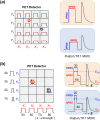Silicon photomultiplier signal readout and multiplexing techniques for positron emission tomography: a review
- PMID: 35892029
- PMCID: PMC9308856
- DOI: 10.1007/s13534-022-00234-y
Silicon photomultiplier signal readout and multiplexing techniques for positron emission tomography: a review
Abstract
In recent years, silicon photomultiplier (SiPM) is replacing the photomultiplier tube (PMT) in positron emission tomography (PET) systems due to its superior properties, such as fast single-photon timing response, small gap between adjacent photosensitive pixels in the array, and insensitivity to magnetic fields. One of the technical challenges when developing SiPM-based PET systems or other position-sensitive radiation detectors is the large number of output channels coming from the SiPM array. Therefore, various signal multiplexing methods have been proposed to reduce the number of output channels and the load on the subsequent data acquisition (DAQ) system. However, the large PN-junction capacitance and quenching resistance of the SiPM yield undesirable resistance-capacitance delay when multiple SiPMs are combined, which subsequently causes the accumulation of dark counts and signal fluctuation of SiPMs. Therefore, without proper SiPM signal handling and processing, the SiPMs may yield worse timing characteristics than the PMTs. This article reviews the evolution of signal readout and multiplexing methods for the SiPM. In this review, we focus primarily on analog electronics for SiPM signal multiplexing, which allows for the reduction of DAQ channels required for the SiPM-based position-sensitive detectors used in PET and other radiation detector systems. Although the applications of most technologies described in the article are not limited to PET systems, the review highlights efforts to improve the physical performance (e.g. spatial, energy, and timing resolutions) of PET detectors and systems.
Keywords: Multiplexing; Positron emission tomography (PET); Radiation detector; Silicon photomultiplier (SiPM); Time-of-flight (TOF).
© The Author(s) 2022.
Conflict of interest statement
Conflict of interestHaewook Park declares that he has no conflict of interest. Minseok Yi declares that he has no conflict of interest. Jae Sung Lee is the editor in chief of Biomedical Engineering Letters.
Figures



















References
-
- Anger HO, Gottschalk A. Localization of brain tumors with the positron scintillation camera. J Nucl Med. 1963;4(4):326–330. - PubMed
Publication types
LinkOut - more resources
Full Text Sources
Other Literature Sources
Miscellaneous
